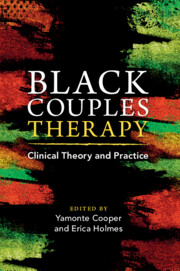Book contents
- Black Couples Therapy
- Black Couples Therapy
- Copyright page
- Contents
- Figures
- Tables
- Contributors
- Foreword
- Acknowledgments
- Introduction
- Part I Race, Racism, and Identity
- Part II Foundations for Healthy Coupling
- Part III Adapting Major Therapeutic Approaches for Work with African American Couples
- Chapter 6 Emotionally Focused Therapy with Black Couples
- Chapter 7 Use of the Gottman Method with African American Couples Impacted by Post-Traumatic Slave Syndrome
- Chapter 8 Transcending the Binary: A Narrative Therapy Approach to Work with Black Trans Men Navigating Gender Transition with Romantic Partners
- Chapter 9 Imago Therapy and the African American Couple
- Chapter 10 African American Narratives of Trauma: An EMDR Approach to Tapping into the Strengths of Black Love
- Part IV Sex and Intimacy
- Part V Special Topics
- Index
- References
Chapter 6 - Emotionally Focused Therapy with Black Couples
from Part III - Adapting Major Therapeutic Approaches for Work with African American Couples
Published online by Cambridge University Press: 27 July 2023
- Black Couples Therapy
- Black Couples Therapy
- Copyright page
- Contents
- Figures
- Tables
- Contributors
- Foreword
- Acknowledgments
- Introduction
- Part I Race, Racism, and Identity
- Part II Foundations for Healthy Coupling
- Part III Adapting Major Therapeutic Approaches for Work with African American Couples
- Chapter 6 Emotionally Focused Therapy with Black Couples
- Chapter 7 Use of the Gottman Method with African American Couples Impacted by Post-Traumatic Slave Syndrome
- Chapter 8 Transcending the Binary: A Narrative Therapy Approach to Work with Black Trans Men Navigating Gender Transition with Romantic Partners
- Chapter 9 Imago Therapy and the African American Couple
- Chapter 10 African American Narratives of Trauma: An EMDR Approach to Tapping into the Strengths of Black Love
- Part IV Sex and Intimacy
- Part V Special Topics
- Index
- References
Summary
This chapter examines Emotionally Focused Therapy (EFT) with Black couples. Important clinical considerations (e.g., racial realities of anti-Blackness) are provided that must be integrated within the EFT therapy model to provide an appropriate adaptation that is culturally responsive couples therapy. EFT and attachment theory will need to be significantly modified to be a culturally responsive therapy to meet the needs of Black couples. Adult attachment needs to be conceptualized from a network approach (e.g., multiple relationships/collectivism) instead of only a dyadic perspective. In addition, acculturation (i.e., racial identity), race/ethnicity, institutional decimation and Black sex ratios, marriage, anti-Black racism, internalized stereotypes (anti-Blackness), Strong Black Woman/Superwoman Schema, John Henryism, and religion and spirituality are all important factors to consider in providing culturally responsive care and clinical interventions that strengthen treatment approaches with Black couples.
Keywords
- Type
- Chapter
- Information
- Black Couples TherapyClinical Theory and Practice, pp. 127 - 165Publisher: Cambridge University PressPrint publication year: 2023



